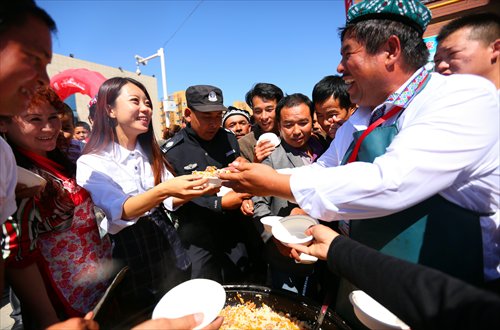Model village
Xinjiang community sets example of ethnic cohesion

An Uyghur chef gives a bowl of "hand pilaf" to a Han woman at a Daxi village square in the Xinjiang Uyghur Autonomous Region on September 9, as local residents celebrate a harvest festival. Photo: courtesy of Li Fei
Wu Guixia regretted her decision to get married the minute she set foot in the village of Daxi in Northwest China's Xinjiang Uyghur Autonomous Region. In 1980, a peasant husband, an adobe house, the howling wind and expanses of sand and dust were all she had in the village.
But in 2014, Daxi was acclaimed as one of the top 10 well-off villages in China, as it boasted an average individual annual income of 25,000 yuan ($3,910), making it one of the richest villages in Xinjiang. By May 2014, more than 60 households in Daxi had an annual income of more than 500,000 yuan and over 20 households made over 1 million yuan.
Located in Yuli county of Bayingolin Mongolia Autonomous Prefecture, Daxi takes its name from the Uyghur word for saline soil. For decades, hundreds of ethnic Han people like Wu's family came to the majority-Uyghur village. By 2014, 28 percent of the village's 2,279 residents were ethnic Han people.
That year Chinese President Xi Jinping wrote a letter to the villagers whom he met in 2009 when he was vice president. Xi said that the development and changes in Daxi showed that a prosperous life can be achieved by villagers with supporting policies and a united community of different ethnic groups.
The letter triggered public discussion as to whether Daxi's development model could be promoted in Xinjiang, as the region struggles to improve ties between Han and Uyghur people after multiple terror attacks.
Led from above
Speaking with a strong accent that reveals her origins in Central China's Henan Province, the 57-year-old Wu said that the village's achievements were only possible thanks to the village's Party chief, Sawut Monlik. "He knows every household in Daxi and how our lives are. He may be old, but he is always ready for new ideas," Wu said.
Since 1980, when Monlik started working in Daxi, the ethnic Uyghur began to organize villagers to build irrigation ditches and open up the saline soil for farming, which was followed by the construction of factories and greenhouses.
In June this year, Monlik inked a long-term strategic cooperation agreement with his counterpart in Huaxi, Jiangsu Province, the richest village in China. The two villages in September launched their first cooperation project on a 20-megawatt photovoltaic plant in Daxi.
Harmony from below
Observers pointed out that Daxi's real strength lies in its united community, which is built upon a couplet-assistance program in the village - a practice commonly used in China for poverty relief in which two families do what they can do to help each other.
Wu joined the program in the 1990s with Turyhun Ali, whom she grew familiar with after years of working together. "We see each other like family and we celebrate both Han and Uyghur festivals together," she said.
Other families developed bonds through supporting each other, including Yang Shengzhang and Memet Sawut, as Memet, a Uyghur, offered both financial and technological aid to Yang's family when they first arrived in Daxi in 1997.
"Local Uyghurs used to leave their sick children with Han families as they could not speak Putonghua to communicate with doctors. Han families would then help the children get treatment. This is how close we are," said Chen Lei, deputy county head of Yuli.
"All the good relations were formed naturally over years of living and working together. The government was not involved when families came together to help each other and later became part of the program," Wu said.
Wu added that families in the program will be assessed every year and those with closer ties and higher incomes will be rewarded with several hundred yuan as stimulus.
Teaching religious teachers
Apart from the unity between Han and Uyghur residents, the village's code of conduct also focused on religion, as part of the region's fight against Islamic extremism.
The only mosque in Daxi is equipped with a reading room where believers can learn about both farming and Islam, while a board displaying the full text of the regional religious affairs administration regulations hangs at the entrance of the mosque.
"Daxi has been working to train religious figures with agricultural knowledge so as to make them good examples to believers," Memet Emet, vice chairman of Yuli County Committee of the Chinese People's Political Consultative Conference, told the Global Times.
In 2013, the seven religious heads in Daxi earned 25,000 yuan per year on average, some 2,000 yuan higher than the average income that year, reported Xinjiang Daily.
The 56-year-old imam at Daxi's mosque, Tursun Hasan, was trained to grow cotton and pears in the 1990s. His 7.2-hectare plantation now earns him over 100,000 yuan annually.
Hasan gives lectures on the government's religious and agriculture policies after religious services. Hasan also lectures on the benefits of an ethnically united community.
"This is an era where religion and science are no longer in conflict. Religious figures are often better educated and they tend to respect knowledge more, which offers authorities an opportunity to train them and help them develop expertise," Sun Lizhou, a deputy dean of Southwest University of Political Science and Law, told the Global Times.
Speaking at the village's first harvest festival on September 9, Ma Wenyu, Party chief of Yuli, said that the Daxi model is now being promoted in the whole county and some 20,000 residents have been involved in the couplet-assistance program.
"The language barrier will become a key obstacle for the couplet-assistance program to be set up in those regions, or when experts who cannot speak Uyghur try to offer training to local Uyghurs," Sun explained, calling for local authorities to expand bilingual education for ethnic minorities.